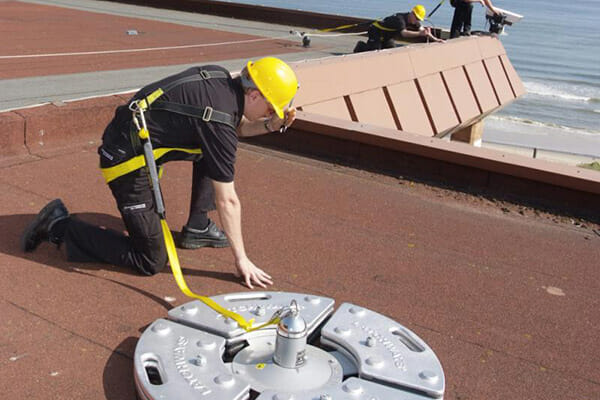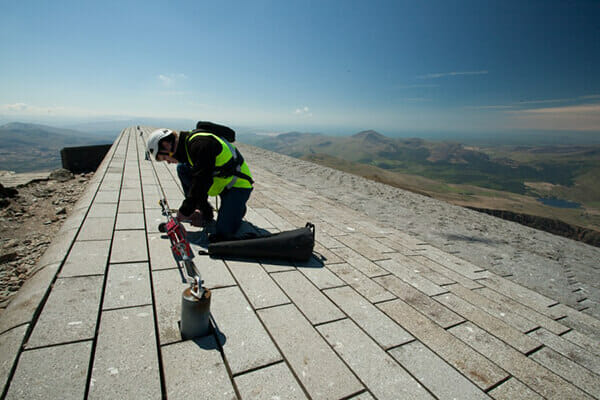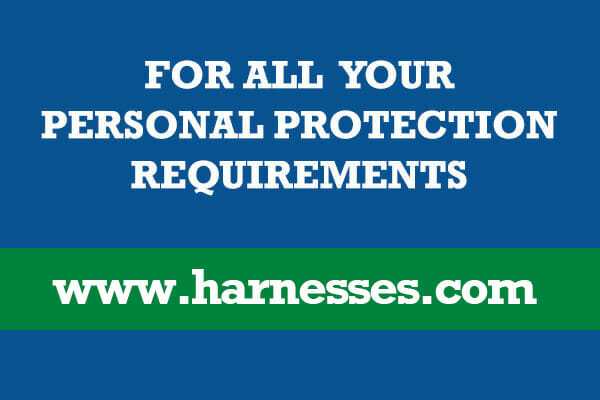Fall Prevention: Fall Arrest vs Fall Restraint.
What is the difference between different types of fall protection helping with fall prevention?
| Fall Prevention | Fall Restraint | Fall Arrest | |
|---|---|---|---|
| How does it protect? | Prevents people from reaching the fall hazard by creating a barrier between the person and the fall hazard | Prevents people from reaching a fall hazard through a tie off system. | Stops a fall that is in progress through a tie off system. |
| Equipment Needed | No individual equipment | Custom fitted equipment | Custom fitted equipment |
| Training Needed | None | Yes, extensive and ongoing | Yes, extensive and ongoing |
| Inspection | After Install and Annually | Every Use by the Individual | Every Use by the Individual |
| Maintenance | Annually | Must be inspected and cared before and after every use. | Must be inspected and cared before and after every use. |
| Potential for Injury | None | Mild | High |
| Costs | Higher up front costs. | Lower initial costs but hidden costs might be: training, equipment maintenance, and setup time. | Lower initial costs but hidden costs might be: training, equipment maintenance, and setup time. |
| Burden to Laborer | Little to none. | Must inspect and properly wear their equipment. | Must inspect and properly wear their equipment. |
| EU Directives Preference | Preferred because there is the least risk. | Better than fall arrest. |
| Fall Prevention | |
|---|---|
| How does it protect? | Prevents people from reaching the fall hazard by creating a barrier between the person and the fall hazard |
| Equipment Needed | No individual equipment |
| Training Needed | None |
| Inspection | After Install and Annually |
| Maintenance | Annually |
| Potential for Injury | None |
| Costs | Higher up front costs. |
| Burden to Laborer | Little to none. |
| EU Directives Preference | Preferred because there is the least risk. |
| Fall Restraint | |
|---|---|
| How does it protect? | Prevents people from reaching a fall hazard through a tie off system. |
| Equipment Needed | Custom fitted equipment |
| Training Needed | Yes, extensive and ongoing |
| Inspection | Every Use by the Individual |
| Maintenance | Must be inspected and cared before and after every use. |
| Potential for Injury | Mild |
| Costs | Lower initial costs but hidden costs might be: training, equipment maintenance, and setup time. |
| Burden to Laborer | Must inspect and properly wear their equipment. |
| EU Directives Preference | Better than fall arrest. |
| Fall Arrest | |
|---|---|
| How does it protect? | Stops a fall that is in progress through a tie off system. |
| Equipment Needed | Custom fitted equipment |
| Training Needed | Yes, extensive and ongoing |
| Inspection | Every Use by the Individual |
| Maintenance | Must be inspected and cared before and after every use. |
| Potential for Injury | High |
| Costs | Lower initial costs but hidden costs might be: training, equipment maintenance, and setup time. |
| Burden to Laborer | Must inspect and properly wear their equipment. |
| EU Directives Preference |
Fall Restraint, Fall Arrest, and the Hierarchy of Fall Protection.
Understanding the difference between fall restraint and fall arrest is essential when planning safe work at height. These terms are widely used across the fall-protection industry, but specifying the correct system requires knowing how and why each one is applied. The information below provides a foundation for making those decisions, and additional resources throughout Fallarrest.com offer further guidance.
The Hierarchy of Fall Protection.
Safety authorities generally agree that choosing a fall-protection solution should begin with the established Hierarchy of Fall Protection. This step-by-step approach helps identify the most effective and practical method for reducing risk.
1. Eliminate the Risk.
Avoid working at height whenever possible. Position equipment, plant, or access points at ground level or in areas where no fall hazard exists.
2. Guard the Hazard.
When work at height cannot be avoided, prevent exposure to the fall risk. Install guardrails, parapets, or other physical barriers that remove the possibility of a fall.
3. Protect the Worker.
If the hazard cannot be eliminated or guarded, a fall-protection system must be used to minimise the potential consequences of a fall. This is where fall restraint and fall arrest come into play—two fundamentally different solutions designed for different scenarios.
In short:
-
Fall restraint prevents the user from reaching the hazard.
-
Fall arrest allows access to the hazard but protects the user after a fall occurs.
See our video section for visual demonstrations of both systems.
Fall Restraint.
A fall-restraint system gives the worker the freedom to perform their tasks while preventing them from reaching any point where a fall could occur.
Fall restraint is ideal when:
-
Work needs to be completed near an exposed edge.
-
There are other fall hazards present, such as fragile roofing, skylights, or open vents.
Because misuse can occur—such as using a lanyard that is too long—fall-restraint systems are often tested to fall-arrest loads for added assurance.
Typical installation guidelines:
Fall-prevention systems are generally placed more than 2.3 m from the hazard. This accounts for the common use of a 1.8 m fixed-length lanyard when connecting the worker to the system.
Fall Arrest.
Fall-arrest systems are designed for situations where workers must access the fall hazard itself, such as roof edges during gutter maintenance.
These systems:
-
Allow maximum mobility.
-
Enable the worker to reach areas where a fall is possible.
-
Arrest the fall and limit impact forces if the worker slips or loses balance.
After a fall is arrested, the worker must either perform a self-rescue or be assisted through a planned rescue procedure.
Rescue Planning.
Any time fall-arrest equipment is used, a comprehensive rescue plan is legally required. Employers must ensure that fallen workers can be retrieved quickly and safely to prevent further injury.
Rescue options may include:
-
Personal rescue devices
-
Specialist harness systems
-
Assisted or fully managed rescue procedures
Visit our demonstration video to see how personal rescue equipment is deployed in a real-world scenario.
Fall Arrest vs Fall Restraint
The difference between Fall Arrest and Fall Restraint





